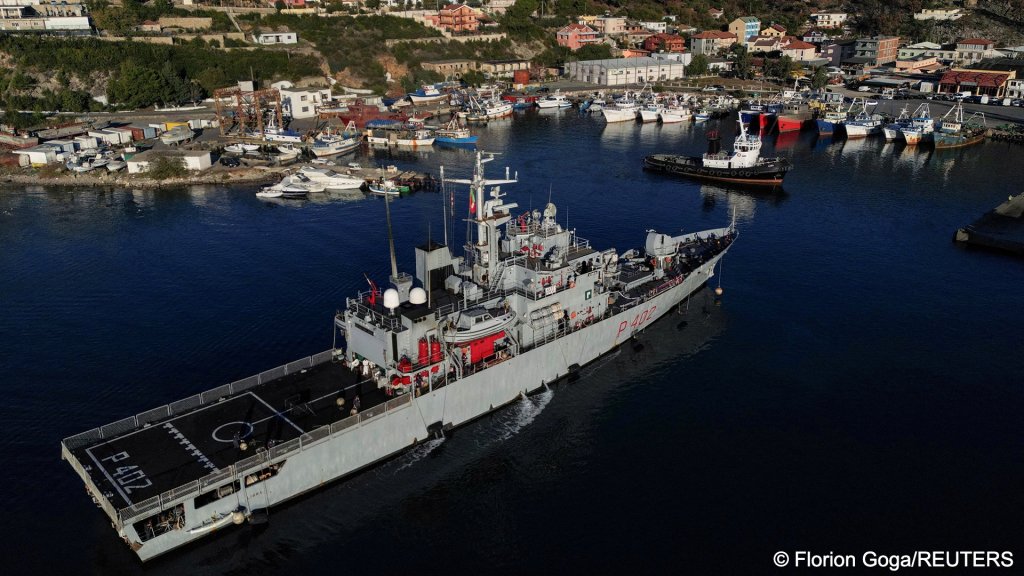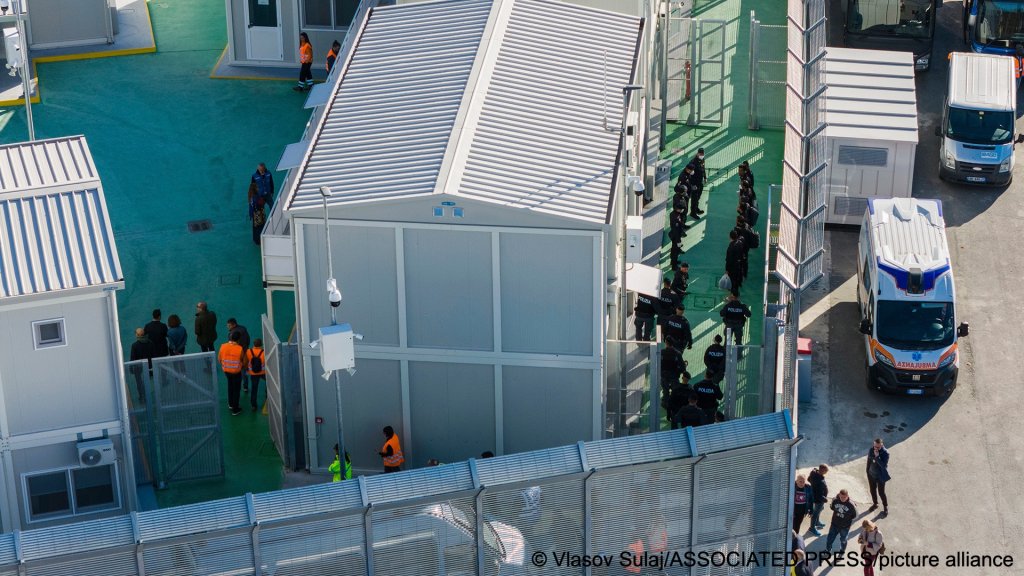One migrant from a second group sent to Albania by Italy has been returned after being deemed "vulnerable." The other seven migrants are expected to also return to Italy following a court decision late Monday.
On Saturday, November 9, an Egyptian migrant was diagnosed with "psychological problems," and returned to Italy, reported the news agency AP. The decision was announced by a delegation of Italian activists and lawmakers who visited the center on Saturday.
The man was one of just eight migrants, alongside five from Bangladesh and two others from Egypt who arrived in Albania on Friday (November 8). After a decision by Rome's migration tribunal late on Monday (November 11), the rest of the seven migrants are also expected to be returned to Italy.
An interior ministry source confirmed that the migrants would have to be transferred shortly to Italy, news agency AFP reported on Monday afternoon.
Italian newspaper Il Fatto Quotidiano, added that the tribunal's suspension of judgement related to the migrants's detention, and referral to the European Court of Justice (ECJ) meant that the Italian government would be faced with no choice but to send the migrants back to Italy, since their detention in Albania couldn't be completed within the statutory 48-hours required by the agreement.
Second group to be sent back
The Rome Tribunal's referral follows similar referrals by courts in Bologna and Palermo in recent weeks. The lead judge responsible for the referral, Luciana Sangiovanni, stated in a note accompanying the decision, that the panel of judges judged a referral "the best course of action, rather than issuing another autonomous judgement," reported Il Fatto Quotidiano.
The group is just the second to have been sent to Albania by Italy under the terms of the bilateral agreement which began operations in October this year, after a delayed start. Within a few days, all of the migrants in the first group, also from Bangladesh and Egypt, were also sent back to Italy following a court decision.
The Italian government then passed an emergency decree, with "immediate effect" to try and guard against similar decisions being made by the courts over the next group of migrants sent to Albania.
In their decision on Monday, the Italian judges added that following this decree, they believed it was up to the EU court system to evaluate whether or not Italian national law was compatible with current European rulings.
Read AlsoItalian navy ship arrives in Albania with eight migrants
Decree passed
The decree aimed to remove the exception clauses concerning safe countries. Currently, although there are several countries listed as "safe" by the Italian government and other EU member states, including Egypt and Bangladesh, certain parts of the country or certain categories of people from that country could still be considered "at risk" if they were to remain in their country.
According to previous European Court of Justice (ECJ) judgements, those exceptions prevented the whole country from being considered "safe," which could have hampered still further the categories of people Italy would be allowed to send to Albania.

Under the terms of the agreement between Italy and Albania, only male migrants who have been deemed non-vulnerable, who come from so-called "safe countries" and who were picked up by the Italian authorities in international waters, can be sent to Albania to have their asylum claims assessed there under Italian law.
The Italian government states that it wants the Albanian policy to function as a deterrent. They say they aim to hear migrants' asylum claims within a few days of arriving at the center, and then, if their asylum claims are rejected, the government intends to return them to their home country as soon as possible.
Mired in legal processes
However, a few days after the centers finally opened in October, the first cohort of 16 migrants had only been in Albania for about two days before they were ordered back to Italy. First, four of the migrants were found on initial assessment at the Albanian port of Shengjin to either be minors, or vulnerable.
The remaining 12 were then put on a boat back to Italy within days of arrival after the Rome Migration Tribunal deemed that they had the right to have their cases heard in Italy, and not in Albania. The Rome tribunal based their decision on a previous ECJ ruling regarding safe countries.
Lawyer Lucia Gennari, an associate of the Italian Association of Juridical Studies on Immigration (ASGI) told InfoMigrants in October that despite Italian government appeals against the Rome tribunal’s decision, Italian legal experts were waiting on a second European court decision, that they believed will "exclude the possibility of considering a country safe when there are exceptions for certain categories of people. For example Bangladesh, which has a lot of exempted categories of people."

European law typically takes precedence over conflicting national laws. However, the Italian government continues to say that their list of safe countries should "provide stability [for judges] when applying these important procedures."
Read AlsoMore migrants to be taken to Albania under Italy deal despite sentences
Deal will be reinforced by coming EU policy, hopes Italian government
Italian Interior Minister Matteo Piantedosi told journalists in October that he expected the Albanian deal to gain a new lease of life under the EU’s new pact on asylum and migration, which was, in his view, all about the obligation to accelerate border procedures, and would apply "similar criteria regarding 'safe countries.'"
Raising the number of returns, insisted Piantedosi, "is a task assigned to us by Europe. It is also something the Italian public is expecting of us."
Italy’s public broadcaster Rai, estimated that the first group of asylum seekers transported to Albania might have cost the government around 20,000 euros per person, if you factor in the costs of transporting them on the Italian naval vessel both ways, as well as the stay in the centers, which are mostly staffed by Italian police and penitentiary officials.
When challenged about the costs by the Italian media, Piantedosi replied that "when the system is up and running properly, the deterrent effect it will have, will allow us to make significant savings on reception costs."
If the Italian government do get their scheme properly up and running, they hope to be able to process up to 3,000 migrants per month through the two centers, an initial sorting center at the port of Shengjin, and a slightly longer-term detention facility inland in Gjader.
Human rights groups, the Italian opposition and non-governmental organizations have criticized the scheme, saying it conflicts with international laws governing asylum. The Italian government insists that is not the case, saying that anyone who is found to be in need of protection would be welcomed back in Italy.
With AP
